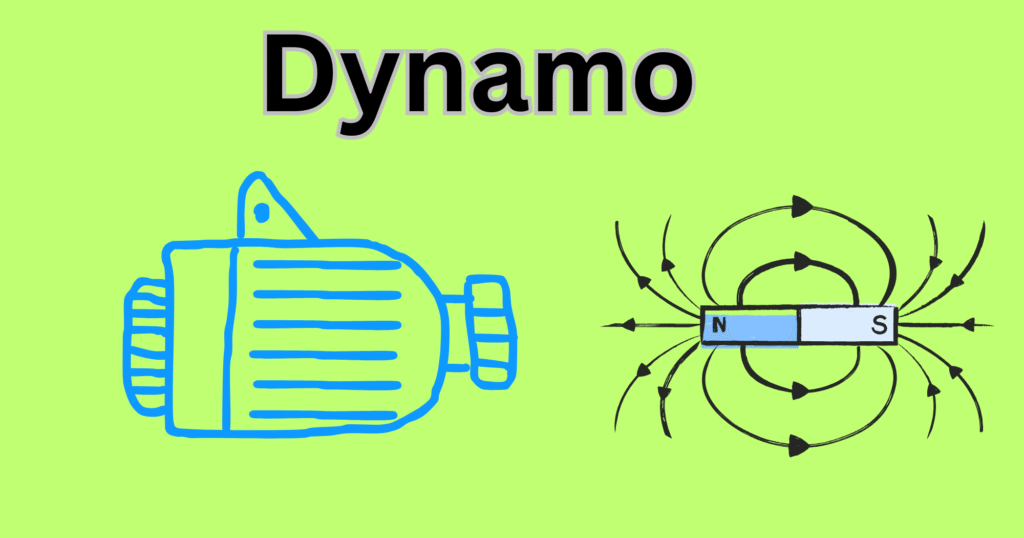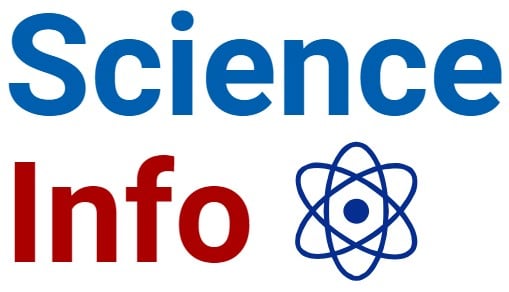Introduction to Dynamo: Definition and Principle
A dynamo is one of the major applications of electromagnetic induction. It converts mechanical energy into direct current (DC) electrical energy. It is a traditional electricity generator that generates energy on a huge scale. It played a huge role in the evolution of industries and became a pillar for the advancements in technology.
Faraday’s Law of Electromagnetic Induction comes into play for Dynamo. In a dynamo a rotor or a rotating coil is placed inside a strong magnetic field to induce an EMF. Hence, an electric current is produced. Commutator is the important component of a dynamo, giving a uniform, stable direction to that fluctuating current produced. Thus, they are capable of producing DC energy. In modern days, rectifiers have replaced dynamos. However, dynamo will always remain as a predator for every modern discovery. They are still being applied in small-scale applications like in bicycle lighting systems and portable hand-crank generators.
Thus, the dynamo is a revolutionary invention of physics. It shows how basic natural phenomena of magnetism and electricity are successfully employed in practical life..

Historical Development and Invention of the Dynamo
The history of dynamo discovery is quite interesting. It emerged after the discovery of the theories of electromagnetism. Many scientists worked in collaboration for years to reveal this masterpiece.
After Michael Faraday discovered the principle of electromagnetic induction, he immediately developed a Faraday disk which was a single pole (magnetic) generator. It could produce a small but continuous flow of current. Although it was lagging in efficiency, it gave a clue that mechanical energy could be converted into electricity.
In the 1830s and 1840s, scientists such as Hippolyte Pixii and André-Marie Ampère started elaborating the clue left by Faraday. Pixii was a French instrument designer. He used a commutator to create a dynamo which was the first dynamo setup. The same commutator converted oscillating AC to a uniform DC. This invention increased the demand for a dynamo for power generation.
The official work came from Werner von Siemens (Germany) and Charles Wheatstone (England). They separately derived a theory for a self-excited dynamo, where the machine magnetized its coils through its self-electricity rather than permanent magnets. This created a top power and efficient dynamo, bringing a new concept in power generation.
Today, the applications like powered factories, electric lights, telegraphs, and electric railways (in the beginning) etc. are impossible without a dynamo. Thomas Edison did remarkable work using dynamos to produce electricity at homes and cities.
Components of a Dynamo
The dynamo has a specific design with various parts used to generate electricity. The major parts are:
- Yoke (Frame): It is known as a directly visible, external body part of a dynamo.It also provides a path for the magnetic flux.
- Field Magnet: Field magnet is a strong permeable magnet having stronger field so that a coil produces larger electric current.
- Armature Core: It is a laminated iron core that reduces the current flow by changing voltage into electrical current. The armature holds the rotating coils providing a torque and EMF is induced.
- Armature Winding: The wires or conductors are wound around the laminated core. When wound in some specific patterns it carries an induced current.
- Commutator: It is a split copper ring which is connected to the armature winding. It is used to convert thus produced AC into uniform DC.
- Brushes:They are made of carbon or graphite. They are placed in contact with the commutator to collect current and further supply to the external circuit.
- Shaft and Bearings: It is built to support the armature while rotating. It allows smooth rotation in the energy sources like turbines or engines.
In summary, dynamo is generated by a magnetic field where the armature rotates to create an AC, and the commutator and brushes convert the AC input to DC output. This simple formula has become a reliable and strong pillar of electrical engineering and power generation.
Working Principle of a Dynamo
As mentioned above, the dynamo is fully grounded under Faraday’s Law of Electromagnetic Induction. The statement of the law simply states the production of electromotive force (EMF) in the conductor when placed in a magnetic field. Let’s see how it works for a dynamo.
- When the armature rotates within the magnetic field, the wound wires oppose the magnetic flux.
- This motion of the armature induces an EMF in the winding. According to Lenz’s Law, induced current is produced in such a way that it always opposes the cause of its production or the magnetic field where it has been kept. The direction of the variables in Faraday;s law is given by Lenz’s law.
- The induced EMF in the armature is of alternating nature. Conductors move periodically between the north and south poles of the magnetic field.
- The commutator is finally responsible to provide a steady DC current.
The EMF produced depends upon the following factors:
- The strength of the magnetic field
- The speed of rotation of the armature
- The number of turns in the winding
These factors are managed well so that the dynamo can generate electricity of varying voltage and current as required.
Types of Dynamos: Series, Shunt, and Compound
The types of winding done to the armature creates various types of dynamos, which are given below:
- Series Dynamo:
The winding in the field is connected in series with the armature. The series connection produces high current but low voltage. It is used for the systems where large current supply is required at low voltage. For example, electroplating. - Shunt Dynamo:
Here, the winding is connected parallel to the armature that produces a higher resistance. As high resistance blocks the current, it produces small current but high voltage. It is used for lighting purposes and power supply in small industries.
- Compound Dynamo:
It is a common functioning of both series and parallel windings. Thus, it can be used to produce both, high or low currents. Ty has an ability to handle variable loads. It was famous during the 90s and the 20s for the power stations and for general electricity production.
Applications of Dynamos in Daily Life and Industry
Dynamos were the primary source of electricity during the inventory period of electricity. Some important applications are:
- Electric Lighting: Dynamos were used in the street lamps, factories, and homes in the primary days.
- Telegraph and Communication Systems: Telephone and telegraph were highly relied on dynamos to produce a stable DC supply.
- Electroplating and Metallurgy: Electrochemical industries required large amounts of current which were supplied with the use of dynamo.
- Bicycles: Dynamos were also used in the bicycles to light the headlamps. The technique is still famous today in some models.
- Portable Generators: Dynamos are also used in emergency flashlights and radios.
- Early Power Stations: In the 1880s dynamos were used to source the power supply of hundreds of houses.
Advantages and Disadvantages of Dynamos
Advantages:
- Simple design and easy to understand.
- Provides direct current without the need for rectifiers.
- They are reliable and durable power sources for small applications.
- No external power source is needed to generate electric fields.
Limitations:
- Always requires a commutator to produce stable DC. This can add mechanical wear.
- Can only produce small power and alternatives should be used to generate high powers..
- Brushes produce friction and hence efficiency decreases.
- Maintenance cost is higher because of its various components.
Because of these limitations, dynamos have been slowly replaced by alternators in large-scale power generation. However, they have a strong history of electric supply.
Difference Between Dynamo and Alternator
| Feature | Dynamo (DC Generator) | Alternator (AC Generator) |
| Output | Produces DC current | Produces AC current |
| Parts | Requires commutator to convert AC into DC | Uses slip rings rather than a commutator |
| Efficiency | Less efficient due to mechanical wears | More efficient than Dynamo |
| Power Capacity | Suitable for small to medium-scale power generation | Suitable for large-scale power generation |
| Modern Usage | Rarely used in small devices like bicycles | Widely employed in power plants |
These differences show that alternators are dominating dynamos hugely and dynamos just have some rare applications.
Future Scope and Relevance of Dynamos in Modern Technology
Even though alternators have largely replaced dynamos in large power systems, dynamos still have their unique significance. Some relevances are given below:
- Teaching and experiments: It can be used to teach and make practical demonstrations of electromagnetic induction.
- Small-scale Devices: Hand-crank dynamos are used in flashlights, radios and survival kits.
- Renewable Energy Systems: Small dynamos can be attached to wind turbines or other systems to locally generate electricity.
- Rural areas: Dynamos are cost-effective power generating systems for rural areas.
- Emergency use: Dynamos are portable, durable, low-cost and easy configuration devices therefore they are strong alternatives to produce electricity in scarcity.
Conclusion
The dynamo was a remarkable discovery of human kind that was primarily the best way to generate and use electricity. The key operation uses the Faraday law of electromagnetic induction, to produce Direct Current for industries, homes, and communication systems. However, they have been replaced hugely and found only in some rare cases in modern power systems. Still, the device has remained valuable in education, small-scale applications, and portable devices.
The principle of dynamo will always be remembered for its history and is a strong backup for electricity production. Technologies can be developed to bring dynamos in the limelight. The future of electricity can grow more productive, efficient, and durable with cost management, by the use of a dynamo.
References
Rincon, F. (2019). Dynamo theories. Journal of Plasma Physics, 85(4), 205850401.
Roberts, P. H. (1992). Dynamo theory. In Chaotic Processes in the Geological Sciences (pp. 237-280). New York, NY: Springer US.
https://en.wikipedia.org/wiki/Dynamo
https://edisontechcenter.org/generators.html
https://www.merriam-webster.com/dictionary/dynamo
